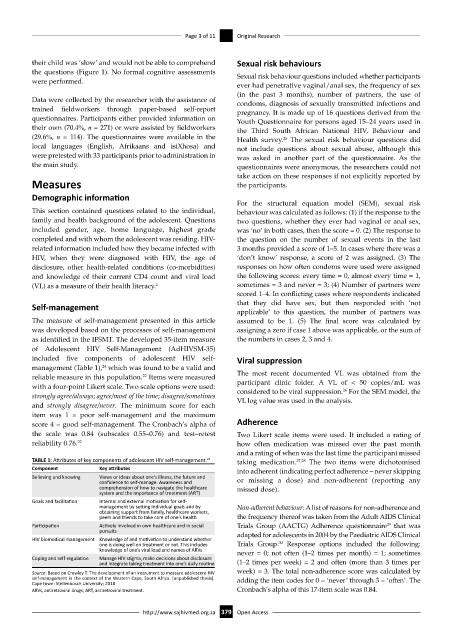Page 387 - HIVMED_v21_i1.indb
P. 387
Page 3 of 11 Original Research
their child was ‘slow’ and would not be able to comprehend Sexual risk behaviours
the questions (Figure 1). No formal cognitive assessments Sexual risk behaviour questions included whether participants
were performed.
ever had penetrative vaginal/anal sex, the frequency of sex
(in the past 3 months), number of partners, the use of
Data were collected by the researcher with the assistance of condoms, diagnosis of sexually transmitted infections and
trained fieldworkers through paper-based self-report pregnancy. It is made up of 16 questions derived from the
questionnaires. Participants either provided information on Youth Questionnaire for persons aged 15–24 years used in
their own (70.4%, n = 271) or were assisted by fieldworkers the Third South African National HIV, Behaviour and
(29.6%, n = 114). The questionnaires were available in the Health survey. The sexual risk behaviour questions did
25
local languages (English, Afrikaans and isiXhosa) and not include questions about sexual abuse, although this
were pretested with 33 participants prior to administration in was asked in another part of the questionnaire. As the
the main study. questionnaires were anonymous, the researchers could not
take action on these responses if not explicitly reported by
Measures the participants.
Demographic information
For the structural equation model (SEM), sexual risk
This section contained questions related to the individual, behaviour was calculated as follows: (1) if the response to the
family and health background of the adolescent. Questions two questions, whether they ever had vaginal or anal sex,
included gender, age, home language, highest grade was ‘no’ in both cases, then the score = 0. (2) The response to
completed and with whom the adolescent was residing. HIV- the question on the number of sexual events in the last
related information included how they became infected with 3 months provided a score of 1–5. In cases where there was a
HIV, when they were diagnosed with HIV, the age of ‘don’t know’ response, a score of 2 was assigned. (3) The
disclosure, other health-related conditions (co-morbidities) responses on how often condoms were used were assigned
and knowledge of their current CD4 count and viral load the following scores: every time = 0, almost every time = 1,
(VL) as a measure of their health literacy. 2 sometimes = 3 and never = 3; (4) Number of partners were
scored 1–4. In conflicting cases where respondents indicated
Self-management that they did have sex, but then responded with ‘not
applicable’ to this question, the number of partners was
The measure of self-management presented in this article assumed to be 1. (5) The final score was calculated by
was developed based on the processes of self-management assigning a zero if case 1 above was applicable, or the sum of
as identified in the IFSMT. The developed 35-item measure the numbers in cases 2, 3 and 4.
of Adolescent HIV Self-Management (AdHIVSM-35)
included five components of adolescent HIV self- Viral suppression
management (Table 1), which was found to be a valid and
24
22
reliable measure in this population. Items were measured The most recent documented VL was obtained from the
with a four-point Likert scale. Two scale options were used: participant clinic folder. A VL of < 50 copies/mL was
26
strongly agree/always; agree/most of the time; disagree/sometimes considered to be viral suppression. For the SEM model, the
and strongly disagree/never. The minimum score for each VL log value was used in the analysis.
item was 1 = poor self-management and the maximum
score 4 = good self-management. The Cronbach’s alpha of Adherence
the scale was 0.84 (subscales 0.55–0.76) and test–retest Two Likert scale items were used. It included a rating of
reliability 0.76. 22 how often medication was missed over the past month
and a rating of when was the last time the participant missed
TABLE 1: Attributes of key components of adolescent HIV self-management. 22 taking medication. 27,28 The two items were dichotomised
Component Key attributes into adherent (indicating perfect adherence – never skipping
Believing and knowing Views or ideas about one’s illness, the future and
confidence to self-manage. Awareness and or missing a dose) and non-adherent (reporting any
comprehension of how to navigate the healthcare missed dose).
system and the importance of treatment (ART)
Goals and facilitation Internal and external motivation for self-
management by setting individual goals and by Non-adherent behaviour: A list of reasons for non-adherence and
obtaining support from family, healthcare workers,
peers and friends to take care of one’s health the frequency thereof was taken from the Adult AIDS Clinical
29
Participation Actively involved in own healthcare and in social Trials Group (AACTG) Adherence questionnaire that was
pursuits adapted for adolescents in 2004 by the Paediatric AIDS Clinical
HIV biomedical management Knowledge of and motivation to understand whether
30
one is doing well on treatment or not. This includes Trials Group. Response options included the following:
knowledge of one’s viral load and names of ARVs never = 0; not often (1–2 times per month) = 1; sometimes
Coping and self-regulation Manage HIV stigma, make decisions about disclosure
and integrate taking treatment into one’s daily routine (1–2 times per week) = 2 and often (more than 3 times per
Source: Based on Crowley T. The development of an instrument to measure adolescent HIV week) = 3. The total non-adherence score was calculated by
self-management in the context of the Western Cape, South Africa. [unpublished thesis]. adding the item codes for 0 = ‘never’ through 3 = ‘often’. The
Cape town: Stellenbosch University; 2018
ARVs, antiretroviral drugs; ART, antiretroviral treatment. Cronbach’s alpha of this 17-item scale was 0.84.
http://www.sajhivmed.org.za 379 Open Access

